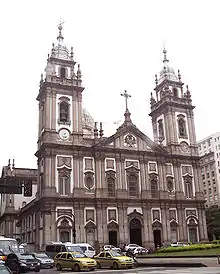Candelária massacre
The Candelária massacre (Portuguese: chacina da Candelária [ʃɐˈsĩnɐ ðɐ kɐ̃deˈlaɾjɐ]) was a mass killing in Rio de Janeiro, Brazil, on July 23, 1993. During the night, eight homeless people, including six minors, were killed by a group of men beside the Candelária Church. Several of the men were members of the police and were tried for the killings, but only two were convicted.

Background
The Candelária Church is a famous historic Roman Catholic church in central Rio de Janeiro, Brazil. The church itself and the buildings around it in Pius X Square became known as a popular location for possibly hundreds of Rio de Janeiro's street children to form a makeshift home at night. The church's personnel provides food, shelter, education and religious advice to as many of these children as possible. Many of the homeless children are involved with the illegal drug trade and prostitution, and because many of these children also live around the church during the day, police keep a constant watch on the church's surroundings. In the early 1990s, the area around the Candelária Church developed a high crime rate as street children increasingly began to commit criminal activities such as pickpocketing and robbery.
Massacre
According to survivors, on the morning of July 22, 1993, the day before the massacre, a group of children threw stones at police cars, with some of the policemen allegedly saying "don't worry, we will get you soon!" to threaten them. As the children from the Candelária Church area were usually only given warnings by policemen, the young perpetrators left without worrying too much about the threat. At midnight, several Chevrolet Chevette cars with covered license plates came to a halt in front of the Candelária Church, and the occupants began shooting at the group of roughly seventy street children sleeping in the vicinity of the church.
List of those killed
- Paulo Roberto de Oliveira, 11 years old
- Anderson de Oliveira Pereira, 13 years old
- Marcelo Cândido de Jesus, 14 years old
- Valdevino Miguel de Almeida, 14 years old
- "Gambazinho", 17 years old
- Leandro Santos da Conceição, 17 years old
- Paulo José da Silva, 18 years old
- Marcos Antônio Alves da Silva, 20 years old
Aftermath
Six children and two adults were killed and numerous others were wounded outside the Candelária Church. Subsequently, during the investigations the shots were found to be fired by policemen, and fifty officers were accused of the massacre. One of them, Mauricio da Conceição, died during a shootout as he was about to be arrested in 1994. Two others, Marcos Emmanuel and Nelson Cunha, were handed sentences equivalent to life sentences. However, they could potentially avoid the imprisonment, as Brazilian law says that anyone who gets a sentence of twenty or more years in jail, automatically qualifies for a second trial. One of the children that survived that attack was supposedly shot several times before he could testify against policemen that were to go to trial, and ended up fleeing from Brazil in order to save his life.
The international community severely condemned the attack, and many in Brazil asked for the prosecution of those who shot the Candelária Church children.
The event also was mentioned in the song The Candelaria Massacre recorded by a Brazilian death metal band Lacerated And Carbonized (from the 2013's album The Core of Disruption).
Survivors
A social worker who later tracked the fate of these homeless survivors of the Candelária massacre found out that eventually 39 of them were either killed by police or by elements of street life, and discusses this in Bus 174, centered around the Nascimento incident.
See also
External links
- Movie review and director interview
- Amnesty International report and information
- Brazilian trooper convicted of slaughtering street children, CNN.com, May 1, 1996
- Trial begins for Rio police accused of killing homeless kids, CNN.com, December 9, 1996
- Killing of 4 Beggars Shocks Rio And Recalls Earlier Massacre, New York Times, December 12, 1997